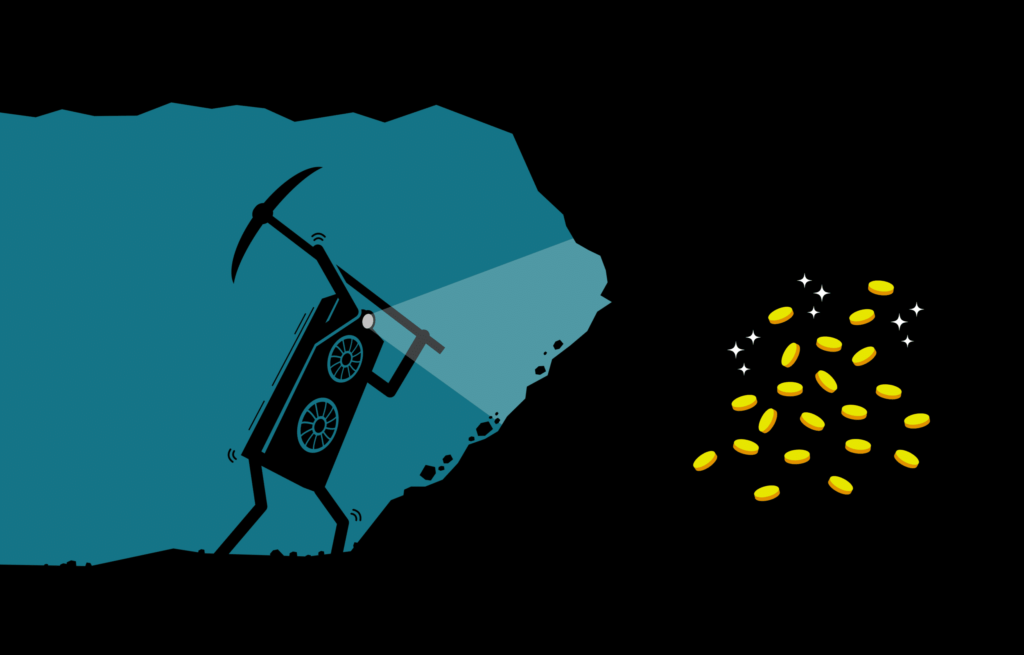
Crypto mining skyrocketed in 2023 – it was a literal gold rush. Everybody was suddenly interested in it, how it worked, and how to make money with it. Despite its huge spike, the frenzy quickly calmed down. Even though it is still profitable to be a cryptocurrency miner in January 2023, there are certain obstacles. Let us discuss how you can mine Bitcoin (BTC) in a legal way.
Unlike popular belief, crypto mining is not only done to mine cryptocurrencies for yourself. It also provides security to the transactions on the blockchain network.
A blockchain network is a digital ledger in which transactions are grouped linearly in blocks. This network of blocks forms the distributed ledger of the blockchain. When users execute a transaction on a blockchain, the system should ensure that double-spending does not occur. Since a blockchain is a decentralized system, there is no legal entity that keeps this in check. Therefore, crypto miners provide their computing power in exchange for some cryptocurrency.
Since this process involves the financial security of users, miners are carefully validated using Proof-of-Work (PoW) system. Some newer blockchain networks are based on energy-efficient Proof-of-Stake. However, the original cryptocurrencies, including Bitcoin (BTC) and Ethereum, still work on Proof-of-Work.
When crypto-mining is based on PoW, the miners solve mathematical equations involving cryptographic hashes. Each hash is a digital signature connected with a block of data. When a transaction executes, miners find these hash values using their hardware system resources. In exchange for success, miners are given a part of new coins or cryptocurrencies, such as Bitcoin or Ethereum. Each hash refers to its block and the previous one. Therefore, this linear block system maintains the security of the blockchain network.

Crypto mining requires you to install special software on your computer. In the early days of the original cryptocurrency, i.e., Bitcoin, miners could generate a number of Bitcoins easily using their CPU. However, as time passes and more coins are in circulation, the equations become harder to crack. Consequently, miners needed more computer power to process transactions on the blockchain. Thus, GPU mining started. Users create a pool or network of GPU connected to their computer. This GPU pool provides the required amount of power to the blockchain.
As crypto mining users increased, companies started to manufacture specialized mining rigs. Application Specific Integrated Circuit (ASIC) was designed specifically for mining cryptocurrencies such as Bitcoin (BTC). This hardware costs more money but is much more efficient and faster.
The latest iteration is crypto mining on the cloud. Essentially, a miner pays rent for the hardware and deploys the software on it. With just a click, the miner can mine cryptocurrency from the ease of home. GPUs and ASIC are not only expensive, but they also consume a large amount of electric power. That is why cloud mining is getting more traction these days.
Lastly, mining pools are also popular. Bitcoin and other cryptocurrencies are at a level where it is difficult for a single miner to mine even a part of a coin using their hardware. In mining pools, the cryptocurrency miners combine their computing resources. It becomes easier for them to zero in on a hash and generate a block for transactions. The reward is then distributed in the pool based on shared resources.
Recently, hackers have started to corrupt websites with a software programs. This software uses the host computing power to mine cryptocurrencies. Additionally, some hackers attempt to install malware on your hardware. It runs on your computer, but the hacker gets the reward crypto.
However, in certain countries, the state has banned crypto mining making. The reason is that cryptocurrencies demand a huge amount of electric power. It resulted in a power deficit in some states. Therefore, if you are about to mine some Bitcoins for yourself, you should read the respective laws. If your state prohibits cryptocurrency mining, you can try cloud one.

Of course, the first difficulty in crypto mining is the legal issue. If you get past this one, there are a few more waiting for you. The energy issue is the largest after legal. As discussed, it gets harder to crack the hash function for validating a digital transaction on a blockchain. The more computing power you use, the more energy it will require. And definitely, the operating price will go up.
Not only that, you will have to ensure that the hash rate of your mining rig is always above a certain threshold.
Recently, climate activists have also begun moving against cryptocurrencies. Unlike Bitcoin, Ethereum and other major cryptocurrencies and blockchains are moving towards eco-friendly models. Till then, this is another obstacle.

As time passes, most blockchains will convert to the Proof-of-Stake model. It uses far less power to validate transactions making it energy-efficient. Till that happens, crypto mining will remain a cumbersome process for most miners. Your best bet is to use cloud mining or join a digital currency pool. Still, the fact remains that a blockchain cannot work without miners. You will always get a part of the coins in exchange for your work.
Lastly, if you want to make some profit in this line of work, you will have to learn a lot. Stay with the trends in technology and keep yourself flexible. Happy mining!